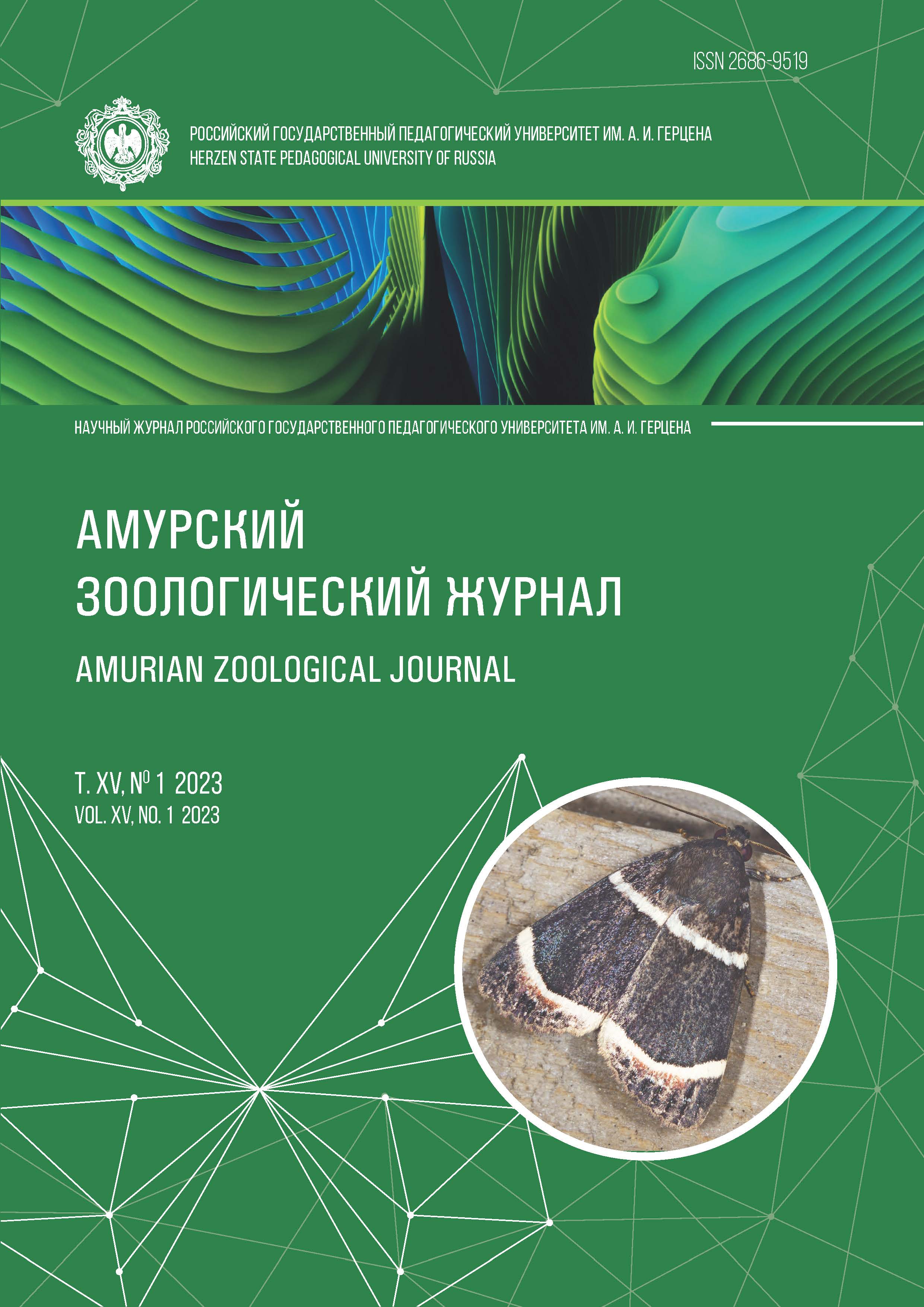Coccidial fauna of pheasants (Phasianus colchicus colchicus)
DOI:
https://doi.org/10.33910/2686-9519-2023-15-1-155-161Keywords:
oosyst, Eimeria, Eimeria phasiani, E. duodenalis, E. colchici, Phasianus colchicus colchicus, Isospora sp.Abstract
Coprological examination of pheasants (Phasianus colchicus colchicus) in different age groups kept in cages in Absheron (Azerbaijan) found Eimeria colchicine, E. Phasiani and E. duodenalis species of genus Eimeria and Isospora spp. of genus Isospora. Two species of genus Eimeria (E. colchici and E. duodenalis) were found in faecal samples of 1–30 day old pheasants, three species of genus Eimeria (E.colchici, E.duodenalis and E.phasiani) — in 31–120 day old birds, one species of genus Isospora (Isospora sp.) and three species of genus Eimeria (E.colchici, E.duodenalis and E.phasiani) — in pheasants over 120 days of age. Generally, three species of genus Eimeria and one genus Isospora were found in pheasants in Azerbaijan. In about 60 pheasants studied, eimeria oocysts were found in 54.5% of 11 pheasants aged 1–30 days, in 66.67% of 18 pheasants aged 31–120 days, and in 82.3% of 41 pheasants over 120 days of age. Infection extensiveness of Isospora spp. among pheasants aged 31–60 days was 5.56% and Isospora sp. was found in 1.67% of the birds studied. No infection with a single species was detected; the invasion found was in the form of a mixed invasion. Among infected birds, Eimeria colchici occured most frequently (86.67%), followed by Eimeria duodenalis (77.33%) and Eimeria phasiani (33.33%). The overall infection extensiveness of pheasants with eimeria was very high — 86.67%.
References
Adl, S. M., Simpson, A. G., Lane, C. E. et al. (2012) The revised classification of eukaryotes. Journal of Eukaryotic Microbiology, vol. 59, no. 5, pp. 429-493. https://doi.org/10.1111/j.1550-7408.2012.00644.x (In English)
Dalloul, R. A., Lillehoj, H. S. (2006) Poultry coccidiosis: recent advancements in control measures and vaccine development. Expert Review of Vaccines, vol. 5, no. 1, pp. 143–163. https://doi.org/10.1586/14760584.5.1.143 (In English)
Duzsynski, D., Couch, L., Upton, S. J. (2015) The Coccidia of the World. Parasitology Labaratory. [Online]. Available at: https://www.k-state.edu/parasitology/worldcoccidia/ (accessed). (In English)
Fisher, J. W. (1973) Prevalence of coccidia in game-farm reared pheasant in Iowa. An abstract of a thesis. Des-Moines: Drake University Publ., 36 p. (In English)
Fuller, L., Griffeth, R., McDougald, L. R. (2008) Efficacy of lasalocid against coccidiosis in Chinese ring-necked pheasants. Avian Disease, vol. 52, no. 4, pp. 632–634. https://doi.org/10.1637/8337-042908-Reg.1 (In English)
Gaibova, G. D., Iskenderova, N. G. (2018) Ejmeriidnye koktsidii — vozbuditeli koktsidiozov zhivotnykh i cheloveka v Azerbajdzhane [Eimeria coccidia as pathogens of coccidiosis in animals and humans in Azerbaijan]. International Scientific Agricultural Journal, no. 1-4, pp. 11–17. (In Russian)
Gerhold, R. W., Williams, S. M., Fuller, A. L., McDougald, L. R. (2010) An unusual case of coccidiosis in laboratory-reared pheasants resulting from a breach in biosecurity. Avian Disease, vol. 54, no. 3, pp. 1112–1114. https://doi.org/10.1637/9354-040210-Case.1 (In English)
Golemansky, V. (2017) Review and check-list of coccidian parasites (apicomplexa:Eucoccidiorida) of humans and animals in Bulgaria. Acta Zoologıca Bulgarıca, vol. 69, no. 2, pp. 151–166. (In English)
Györke, A., Kalmar, Z, Pop, L. M, Suteu, O. L. (2016) The economic impact of infection with Eimeria spp. in broiler farms from Romania. Revista Brasileira de Zootecnia, vol. 45, no. 5, pp. 273–280. https://doi.org/10.1590/S1806-92902016000500010 (In English)
Krylov, M. V. (1996) Opredelitel’ prostejshikh parazitov (cheloveka, domashnikh zhivotnykh i sel’skokhozyajstvennykh rastenij) [Determinant of parasitic protozoa (human, domestic animals, agricultural plants)]. Saint Petersburg: Zoological Institute of the Russian Academy of Sciences Publ., 602 p. (In Russian)
Lilić, S., Dimitrijević, S., Ilić, T. (2013) Importance of coccidiosis in poultry production. In: Proceedings of the 10th International Symposium. Modern Trends in Livestock Production, Belgrade, Serbia, 2–4 October. Belgrade: [s. n.], pp.261–278. https://istocar.bg.ac.rs/wp-content/uploads/2015/12/PROCEEDINGS-2013.pdf (In English)
McQuistion, T. E. (1987) Efficacy of ionophorous anticoccidial dings against coccidia in farm-reared pheasants (Phasiamis colchicus) from Illinois. Avian Disease, vol. 31, no. 2, pp. 327–331. (In English)
Musaev, M., Gaibova, G., İsmailova, G. et al. (1998) The Coccidia of the Gallinaceous Birds in Azerbaijan. Turkish Journal of Veterinary and Animal Sicences, vol. 22, pp. 409–413. (In English)
Musaev, M. A., Alieva, F. K. (1983) Koktsidii fazanov v Azerbajdzhane [Pheasant Coccidia in Azerbaijan]. In: Protozoologicheskie issledovaniya v Azerbajdzhane [Protozoological research in Azerbaijan]. Baku: Elm Publ., pp. 37–40. (In Russian).
Norton, C. (1967) Eimeria duodenalis sp.nov. from English covert pheasants (Phasianus sp.). Parasitology, vol. 57, no. 1, pp. 31–46. (In English)
Norton, C. (1976) Coccidia of the pheasant. Folia veterinaria Latina, vol. 6, no. 3, pp. 218–238. (In English)
Peilerdy, L. P. (1974) Coccidia and Coccidiosis. 2nd ed. Budapest: Parey Publ., pp. 193–330. (In English)
Perkins, F. O., Barta, J. R., Clopton, R. E. et al. (2000) Phylum Apicomplexa Levine. 1970. In: J. Lee, G. F. Leedale, P. Bradbury (eds.). An illustrated guide to the protozoa. Vol. I. 2nd ed. Lawrence: Society of Protozoologists Publ., pp. 190–369. (In English)
Williams, R. B. (1978) Notes on some coccidia of peafowl, pheasants and chickens. Veterinary Parasitology, vol. 4, no. 2, pp. 193–197. https://doi.org/10.1016/0304-4017(78)90011-0 (In English)
Downloads
Published
Issue
Section
License
Copyright (c) 2023 Zamina K. Malikova, Elshad I. Ahmadov

This work is licensed under a Creative Commons Attribution-NonCommercial 4.0 International License.
The work is provided under the terms of the Public Offer and of Creative Commons public license Creative Commons Attribution 4.0 International (CC BY 4.0).
This license permits an unlimited number of users to copy and redistribute the material in any medium or format, and to remix, transform, and build upon the material for any purpose, including commercial use.
This license retains copyright for the authors but allows others to freely distribute, use, and adapt the work, on the mandatory condition that appropriate credit is given. Users must provide a correct link to the original publication in our journal, cite the authors' names, and indicate if any changes were made.
Copyright remains with the authors. The CC BY 4.0 license does not transfer rights to third parties but rather grants users prior permission for use, provided the attribution condition is met. Any use of the work will be governed by the terms of this license.







